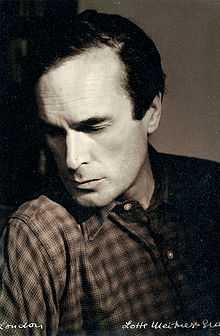Hugo Charteris
| Hugo Charteris | |
|---|---|
 | |
| Born |
11 December 1922 26 Catherine Street, Victoria, London, England |
| Died |
20 December 1970 (aged 48) Elvington, North Yorkshire, England |
| Occupation | novelist, journalist, screenwriter |
| Nationality | Scottish |
| Spouse |
Virginia Mary Forbes Adam (married on 24 April 1948) |
| Children |
Richard Charteris Frances Charteris Jane Charteris Perdita Beckett Jamie Charteris |
Hugo Francis Guy Charteris MC (11 December 1922 – 20 December 1970) was a Scottish novelist and screenwriter. Charteris wrote nine novels, 17 television screenplays and numerous children's books and short stories.
Biography
Charteris was the fourth child of Captain Hon. Guy Lawrence Charteris (1886–1967), the son of Hugo Charteris, 11th Earl of Wemyss and his first wife, Francis Lucy Tennant (1887–1925), a granddaughter of Sir Charles Tennant. Charteris was educated at Eton and in 1941 he left to join the Scots Guards. He was twice wounded in the war, eventually receiving an MC in Italy while defending his position against continuous enemy attack. After the war he went to Malaya and Java where he served as a public relations officer for south-east Asia command (1945-7). At this time he also edited an English language and wrote short stories. He soon left the army and went up to Oxford where he read English at Trinity College for a few frustrating terms (1947-8). In 1948 he married Virginia Mary (born 1922), daughter of Colin Forbes Adam and granddaughter of Beilby Lawley, 3rd Baron Wenlock. Together they had two sons and three daughters. The eldest son, Richard, drowned at their home in Scotland in 1951.
Through his brother-in-law, newspaper baron Esmond Harmsworth, 2nd Viscount Rothermere,[1] he got work with the Daily Mail, where he was sub-editor until he was sent to Paris as second correspondent, mainly writing articles for the continental edition of the Mail.
He retired from full-time journalism in 1951 when he decided to settle in Sutherland, intending to live as a novelist. While being sustained by commissions from Punch and The Telegraph magazines, Charteris wrote his first novel, A Share of the World, which was published in 1953. Francis Wyndham hailed it as "the most impressive first novel that has appeared since the war". Charteris went on to write eight further novels to great critical acclaim. His depiction of the aristocracy was often informed or based upon the lives of his relations. The family in his first novel was based upon his parents-in-law and he portrays Guy, his father, affectionately in many novels. Sir Oswald Mosley, who was related by marriage to his wife's family, launched but later abandoned a libel action over the tragic fascist portrayed in The River Watcher (1965). Charteris later developed a strong friendship with Mosley's son, Nicholas, 3rd Baron Ravensdale, who inspired a Congo mercenary in that same novel.
After 1965 Charteris wrote for television. His most popular work was Take Three Girls (1969–71), based upon a flat-share. His greatest critical success came, however, with The Toggle, a moving portrayal of the helpless isolation of a schoolboy controlled by cold, harsh adults.[2]
Charteris was noted for his beauty in youth and later was gauntly handsome. He died of cancer on 20 December 1970, at his home, The Grange, Elvington, Yorkshire, and was buried in St Helen's churchyard, Skipwith, York.
In 1952 his sister Ann Charteris married Ian Fleming, author of the James Bond novels; she had earlier been married to Esmond Harmsworth, 2nd Viscount Rothermere.[1]
Critical praise for Hugo Charteris:
"Hugo Charteris was among the most gifted British novelists of the postwar generation and The Tide is Right (which was never published in his lifetime) is one of his best books. He wrote, in my opinion, more truthfully about the upper classes than any of his contemporaries. This study of family jealousy and dispossession in an old Scottish landowning family is as exciting as a thriller but its qualities are more than purely narrative. The people and the place are seen with an unmatched intensity and brought to life by a distinctive prose style of rare beauty and extraordinary expressive power."—Francis Wyndham
Novels
- A Share of the World (1953)
- Marching with April (1956)
- The Tide is Right (publication abandoned 1957, published 1991)
- Picnic at Porokorro (1958)
- The Lifeline (1961)
- Clunie (1963, children's novel)
- Pictures on the Wall (1963)
- Staying with Aunt Rozzie (1964, children's novel)
- The River Watcher (1965)
- The Coat (1966)
- The Indian Summer of Gabriel Murray (1968)
References
- ↑ 1.0 1.1 "Anne (sic) Geraldine Mary Fleming (née Charteris)". National Portrait Gallery. Retrieved May 26, 2012.
- ↑ Davenport-Hines, Richard (2004). "Hugo Charteris". ODNB. Retrieved 2010-02-26.
External links
|